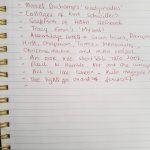This blog will literally flow directly onto the screen from my mind so it may not contain very many coherent thoughts, but hopefully, it will allow me to make some sense of the ideas I have for my research paper topic.

- Researching Robert Rauschenberg, I stumbled onto Marcel Duchamp’s ‘Fountain’. He created this piece under the pseudonym ‘R. Mutt’, an almost comical and unrealistic name, and submitted it to the gallery board that he himself was part of. What was the Fountain? A urinal. Yes. You heard right. Marcel Duchamp purchased an ordinary urinal, signed it and submitted it for an exhibition. I guess he wanted to see the opinions it would generate. Does an object become a work of art simply because the artist chose it? Is art about painstakingly creating the novel? Does a piece need to appreciated as art to be considered art? Does the audience become integral to the artwork? Supplying meaning through interpretation?
- Robert Rauschenberg himself said he wanted to work ‘in the gap between art and life’. What was the distinction between an art object and a mundane object? Must research neo-dadaist and dada art to understand his perspective further here.
- He then swung to the opposing end, emphasizing the creator’s role. Is a work of art a work of art simply because the artist says so? Examples: portrait of Iris Clert, where his submission was a telegram to the gallery saying ‘this is a portrait of Iris Clert if i say so’; erased de kooning drawing; boxes and collage made out of his travels around Europe.
- Apparently this line of thinking falls into the scope of the Dada art movement. These were artists who wanted to discard the value of the aesthetic or logical organization of elements and focus on the absurd or irrational in their artwork. So Dada art was termed anti-art. To paraphrase, if art wanted to please, dada art wanted to offend. It was a form of protest.
- Anti-art, a phrase that sounds fascinating, refers to art that defies conventions. So Dada art is I guess a subset of Anti-art. When Marcel Duchamp used found objects as forms of art, that was termed Anti-art. But then the term is also used to describe revolutionary forms of art. What interests me is that anti-art was attempting to release itself from the cage of conventional art, break through the box so to speak. Ironic then, that in doing so, they put themselves into another box, the box of ‘anti-art’ itself. If you can point to an artwork and say that it is ‘anti-art’, how is that different from classifying things as art. Wasn’t the point of ‘anti-art’ to erase the classifications. Paradox, paradox.
- Anti-art seems quite relevant to my initial question. Who decides what is art? Because anti-art raises the question of whether ‘art’ as a subject exists at all. I dug a bit deeper into the sources at the bottom of the wikipedia article on anti-art because it was SO FASCINATING. I’m just going to jot down a list of titles and keywords that I can look up on the e-library to read further about this subject.
- Found object — an object that already has a non-art purpose, modified and used for artwork. Interesting. They are called art because of the designation placed upon them by the artist. Moreover, the social, cultural history they carry along with the wear and tear. “The artist gives the audience time and stage to contemplate an object.” Okay I’m in love with objects as stories again!
- Assemblage is the term for what I have been trying to do with the clay and mosaic and glass. Noting down the names of some contemporary assemblage artists.
- “Oak Tree” was a rather strange conceptual art piece that I need to look into further. A glass of water is an oak tree? Talk about metaphor. Now this takes my initial thought a step even further. Here the artist is literally using his force of will to suspend the viewer’s literal disbelief. “It would no longer be accurate to call it a glass of water. One could call it anything one wished but that would not alter the fact that it is an oak tree.”
- Marcel Duchamp called aesthetically pleasing art ‘retinal art’ and was not a great fan of it. This is astonishing to me as I have seen the beautiful works he created.
- I feel like when one starts thinking about this notion of ‘what is art’ we start to spiral down a rabbit hole of questions and thoughts. Consider this: “At a Dada ‘anti-art’ exhibition in Paris in the early 1920s, patrons were given access to an axe and encouraged to use it to destroy the art if they felt like it. That action was then itself the work of art that was unfolding.” Destruction = creation. Anti art= art.
Okay that’s about it. Now I will spend a day mulling over what I just wrote.